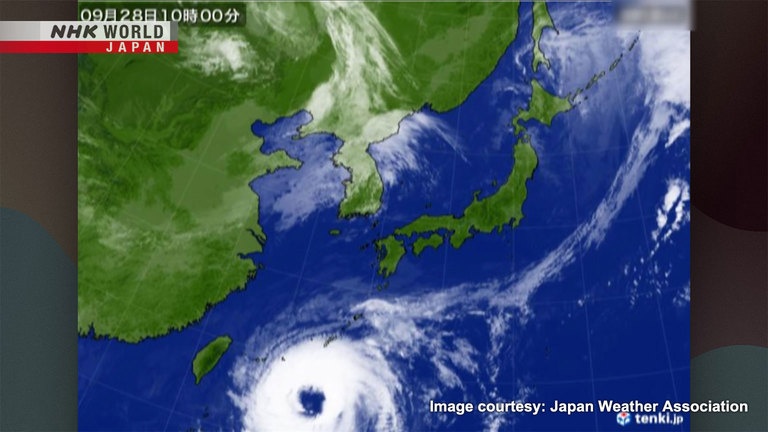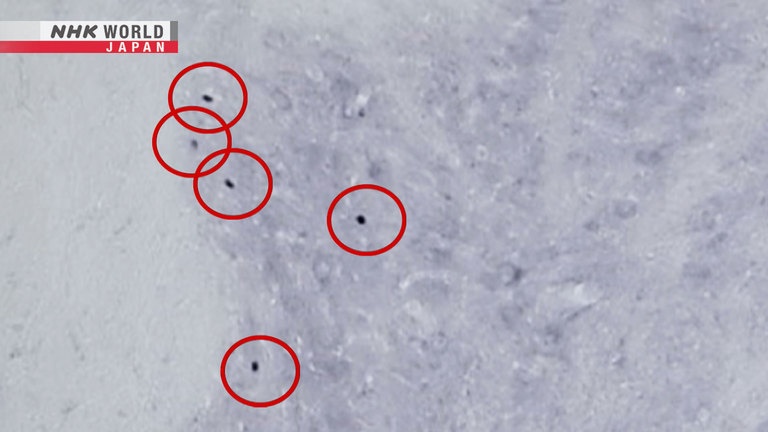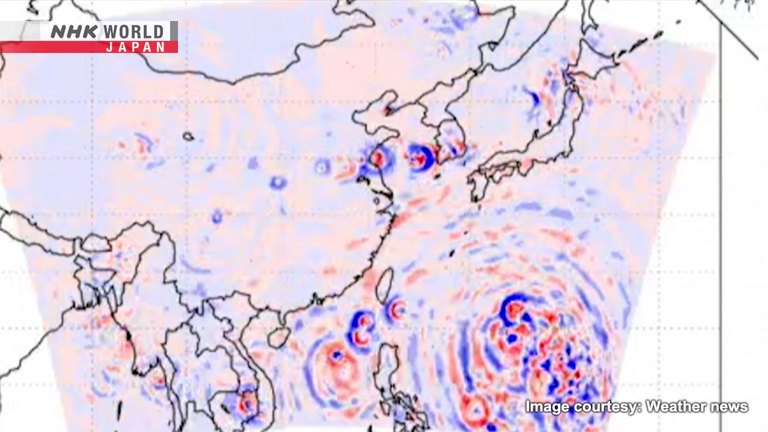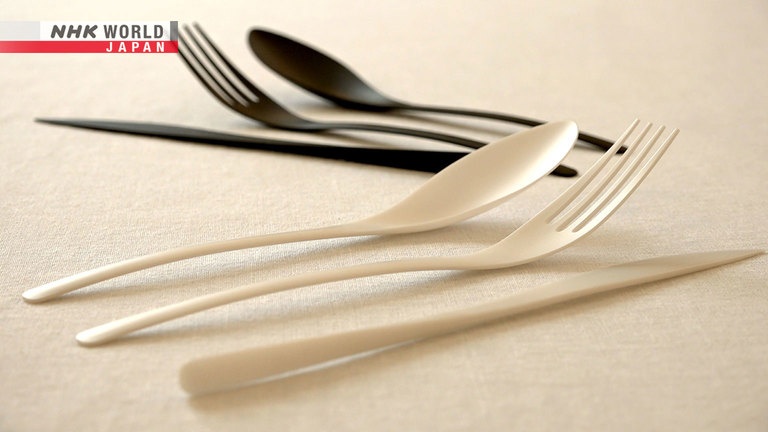It's a Fact - Weather Pains Are Real!
The term "weather pains" encompasses a variety of pains that people feel when the weather changes for the worse, ranging from headaches to stiff shoulders, joint pain, back pain or fatigue. The phenomenon is estimated to affect more than 10 million people in Japan, and its mechanism had long been shrouded in mystery. However, after 15 years of research, a Japanese physician succeeded in identifying the cause – the vestibular system in the inner ear reacting to changes in atmospheric pressure. In this episode, we follow weather pains specialist Dr. Jun SATO as his patients lead him to uncover the three major patterns that prompt weather pains. Then, in our J-Innovators segment, we'll take a closer look at a new type of cutlery that brings out the true flavor of food.
[J-Innovators]
A Flavor Revolution with Zirconia Cutlery




Transcript
Do you suffer from headaches?
When do you get them?
I have headaches whenever the weather is bad.
I get a headache when it's cloudy.
Whenever I feel a headache coming on,
I look outside and find it's raining...
Some people say they experience headaches or pain in their joints when there is a change in the weather.
In fact, if you include those who haven't made the connection to the weather, it is estimated that more than 10 million people in Japan alone suffer from "weather pains."
Yet, despite being a well-known phenomenon, the mechanism behind weather pains was completely unknown.
It took a Japanese researcher 15 years to discover the surprising cause!
There was an unexpected culprit.
It's not what we normally think of
as common knowledge.
Weather pains had been thought to occur when the weather significantly changes for the worse, but medical and weather specialists made a new discovery!
It showed just how much the human body is affected by the weather.
On today's program, we'll investigate the mysterious phenomenon of weather pains!
Hello and welcome to Science View.
I'm your host, Tomoko Tina Kimura.
Today's program is about "weather pains."
Recent research has shed new light on the cause.
With us today is Mr. David Hajime Kornhauser, Director of Kyoto University's Office of Global Communications.
Mr. Kornhauser, it's nice to see you again.
It's great to be back!
Now, fortunately, I've never experienced weather pains.
But, how about you?
Actually, I do get headaches and stiffness in my neck when the weather changes.
Oh, I'm sorry to hear that!
So these are all of the main symptoms of weather pains?
Yes, according to this survey of 8,000 people who are aware of their weather pains, about half of them experience headaches,
while the rest have stiff shoulders, joint pain, back pain, or fatigue.
Mmm, stiff shoulders or fatigue.
That sounds like a very common thing.
Perhaps we just don't know it, but some of our pains are related to the weather.
So, weather pains are nothing new, but it was only recently that a Japanese researcher discovered the mysterious mechanism.
Aichi Medical University has the first "weather pains outpatient clinic" established in Japan.
It sees about 30 patients a day!
The migraine came and got stronger.
Is it better now?
It's getting better.
The founder of this outpatient clinic is Dr. Jun SATO, known as the "weather pains doctor."
Originally an internist, he has been seeing patients suffering from pain.
His research was triggered by the voices of his patients.
My symptoms tend to appear on rainy days.
And then I never want to leave my futon.
Many patients spoke about unexplained health problems due to the weather.
However, they were not regarded as a disease, and sometimes were even thought to just be imagined.
Sato wanted to do something to help, so he set out to find out what was going on.
Bad weather occurs when the atmospheric pressure drops.
So Sato thought that there must be a sensor somewhere in the body that can sense changes in air pressure.
However, when he began his research, other researchers laughed at him, saying, "There's no such thing."
Nevertheless, Sato came up with a hypothesis.
When we fly,
the air pressure changes so much that our ears feel a little strange.
That led me to consider the ear as a place
which is easily affected by atmospheric pressure.
That's right, the ear.
Within the inner ear is the vestibular system, which controls the sense of balance.
When the vestibular nerve senses a change in atmospheric pressure, it gets excited and transmits this information to the brain.
To prove this, experiments were conducted using mice, whose inner ear structure is almost identical to that of humans.
First, the mice were placed in a decompression device to lower the atmospheric pressure.
Sato focused on a protein called "c-Fos," which appears when nerves are excited.
If the vestibular nerve is stimulated by the change in air pressure, then c-Fos will appear in the "vestibular nucleus neurons" in the brain.
Here is a section of a mouse brain
exposed to low pressure.
If the neurons in the vestibular nucleus
respond to changes in atmospheric pressure, c-Fos will appear black on this screen.
Examining it under a high-performance microscope...
Right here!
These black dots are c-Fos,
so the vestibular nerve has responded.
This proves that the inner ear
has reacted to changes in pressure.
How does the change in air pressure sensed by the vestibular nerve cause weather pain via the inner ear?
Here's the mechanism according to Sato.
When a change in atmospheric pressure occurs...
Lymphatic fluid packed in the vestibular system moves and senses the change in air pressure, and the vestibular nerve is stimulated.
Then...
The trigeminal nerve nearby is stimulated, releasing neurotransmitters!
In response, the blood vessels in the brain dilate, which releases inflammatory substances and leads to headaches.
Sato began his research in 2007.
And became the first in the world to clarify the mechanism behind weather pains.
I felt very satisfied.
So Dr. Sato demonstrated that we have air pressure sensors in our ears.
That's right.
Did you know that birds also sense air pressure in their middle ear just like humans?
This tells them things like how high they are flying.
I see.
So headaches, the main symptom of weather pains, are caused by a response of the vestibular nerve.
Is it responsible for other symptoms as well?
It seems that not only the vestibular nerve, but also the autonomic nervous system is involved.
Sato mentioned how the inner ear senses a change in air pressure and transmits it to the brain.
As you may know, the inner ear is what transmits a sense of equilibrium to the brain.
In effect, the inner ear is saying that you're moving, but your sense of sight tells the brain that you're not.
The brain gets confused and your autonomic nervous system reacts.
This makes you feel ill or have other pains.
A disturbance in the autonomic nervous system, I see.
Weather pains are produced by changes in atmospheric pressure.
However, major pressure changes aren't the only time they occur.
The search for the cause was renewed by another patient's comment.
I'd get sick even on a sunny day before it rained, so I thought something had happened to me.
I was so anxious that I couldn't even go to school.
I was even told, "Maybe you're feigning illness."
Before it rained?
Sato wrestled with this problem...
I thought that she might be sensing something before a big change in atmospheric pressure.
What exactly is happening before a big change in atmospheric pressure?
Sato checked the atmospheric pressure at that time...
I reached my limit.
I was in the astronomy club when I was a child,
and I love weather.
Although I'd drawn weather charts, I wasn't an expert and hadn't accumulated data,
so I felt I was limited.
Sato asked weather experts for help, but couldn't find anyone who was interested.
Experts were reluctant to help because of the huge amount of data involved.
Still, Sato did not give up, and eventually, one specialist listened to him.
MORITA Kiyoteru is a weather forecasting and research specialist at a weather information company.
In fact, he was wondering about the same things.
It was just when barometers were
starting to appear on smartphones.
I was measuring all kinds of things
with my smartphone.
Small fluctuations were occurring
even when it was sunny.
They sometimes coincided with
my coworkers not feeling well.
At the time, I wasn't sure of the cause,
so it was bothering me.
So a doctor and a weather expert, two very different specialists, joined forces!
First, they conducted a survey of 160,000 people with weather pains.
The results revealed a surprising trend.
For example, Typhoon Trami hit the Japanese archipelago on September 30, 2018.
We found that the number of people
who were not feeling well began increasing when the typhoon was
still far away from Japan's main islands.
Even though the typhoon was far away, 32% of the respondents felt ill two days before the typhoon's closest approach.
Looking at the weather conditions of the time, we can see there was almost no cloud cover.
There were no major changes in atmospheric pressure.
It's not just about a big change
in atmospheric pressure.
People are sensing something before that
which is affecting their health.
Nobody had noticed this.
It's not mentioned anywhere,
and no one talks about it.
What is happening before a big change in atmospheric pressure, like a typhoon?
The two thoroughly analyzed a vast amount of weather data...
And discovered something hidden in the atmospheric pressure changes used for weather forecasting.
Look closely here, we can see minute fluctuations.
The black line is subtly rising and falling.
A closer analysis of the graph of atmospheric pressure at the time reveals that...
For the two days before the typhoon hit...
Minute fluctuations of about 0.5 hectopascals continued in a jagged pattern.
This is a phenomenon known as "micro-pressure fluctuations."
Here is a map of the micro-pressure fluctuations.
When the super typhoon occurred off the Philippines, far from Japan...
Ripple-like micro-pressure fluctuations, shown in red and blue, were generated around the typhoon, and surged across Japan over two days.
The fact that the pressure changes
are small and oscillating, small in width, but repeating frequently
and at a high rate of speed, can be considered as a very important change.
Even small changes in atmospheric pressure can cause continuous stimulation of the vestibular system, leading to weather pains.
These micro-pressure changes are the reason why people felt ill prior to bad weather.
As for the patient we met earlier...
The biggest thing is that I know the cause.
Now I can predict the pains, which really helps.
Weather pains kept her home during
junior high, but they've never made her
late or absent in high school.
- Do you enjoy high school?
- Yes, it's really fun!
Dr. Sato says anti-vertigo medicine and stretching exercises are helping many of his patients with weather pains.
So the small tremors of micro-pressure fluctuations were the cause?
It seems that way.
Most patients feel ill during these micro-pressure fluctuations.
Research has shown that the inner ear is more sensitive to small changes than to large changes.
Some people with a very sensitive inner ear get motion sickness easily, or suffer from earaches or grogginess when they go to high places.
That's right.
Just when Sato thought he had this all figured out, he discovered another atmospheric phenomenon responsible for weather pains.
Another patient with weather pains presents a new challenge to Sato...
This person suffers from headaches at certain times of the day.
Why is the pain so regular?
Sato tried to figure this one out too.
Again, he thought that there might be some kind of hidden pressure change.
So he consulted with OTSUKA Yasuko, a weather forecaster who had conducted weather pain research with him before.
What came to mind was the phenomenon of "atmospheric tides."
These are periodic fluctuations in atmospheric pressure
caused by the sun's heating of the Earth's atmosphere.
They're observed as waves of atmospheric pressure
that repeatedly rise and fall in a fixed 12-hour cycle.
The sun's rays cause air pressure in the atmosphere to constantly fluctuate up and down.
If we look at the atmospheric pressure at a certain point...
We find that the atmospheric pressure changes regularly in a 12-hour cycle.
The range of fluctuation is about 1 pascal.
After reporting this to Sato...
Our bodies are designed to respond to changes
in environmental rhythms that occur all the time.
There must be some other trigger.
Other trigger?
Otsuka then suspected times when the cycle is distorted.
Looking again at the atmospheric tides, she found large discrepancies from the normal range of fluctuation.
The cycles differed by 2 to 4 hectopascals, and appeared when the daily temperature difference was great.
People tend to feel unwell exactly when
the range of fluctuation is large.
The inner ear is a very sensitive sensory organ, so it probably senses deviations
from the usual rhythm.
Atmospheric tidal displacement was another cause of weather pain!
This is very interesting.
So research has shown that there are three major patterns of weather pains.
That's right.
Large pressure changes.
Micro-pressure fluctuations.
And atmospheric tides.
Sato believes that by applying each of these to his patients, he can find the pressure pattern and pressure change that the patient is struggling with.
Apparently, there are now apps that can forecast weather pains.
Really!?
That must help give advance warning to people suffering from weather pains.
Mr. Kornhauser, thank you very much for joining us today.
Thank you very much, too.
Our next topic today is "cutlery" - utensils like knives, forks and spoons.
There is a new type of cutlery which is said to improve the flavor and taste of the food.
And we have a piece right here.
This spoon may look like it's plastic, but it's not!
It's actually made out of a new material.
It's very strong, just like a metal.
And I've heard that it changes the taste of the food completely.
I would like to try to see if I can actually taste the difference.
So here I have a bowl of soup.
And first, I'm going to try it with this metal spoon, something that I would normally use.
It's very nice!
Now I want to try the same soup with this new spoon.
I actually think it does taste better.
First of all, the spoon feels very nice in the mouth, very soft.
And I think it's because there's no aftertaste of the metal I can actually enjoy the flavor of the soup even better.
This innovative, new type of cutlery was produced by today's Takumi.
This new type of cutlery dramatically changes the taste of food.
Restaurants have taken notice!
Such as this Italian restaurant in Sakura City, Chiba.
The restaurant uses local ingredients to create elegant and original dishes.
But why did the owner pay special attention to the cutlery?
We used to use cutlery made of silver, but I noticed a metallic taste,
a bit like chewing aluminum foil...
However, by using cutlery made of zirconia,
the taste of the food is made clearer.
This cutlery is made of zirconia, also known as artificial diamond.
It was developed by today's Takumi, or innovator, YAMASE Mitsunori.
Zirconia is a ceramic used for dental implants,
which doesn't cause any chemical reactions.
That's why it doesn't affect food taste.
You can enjoy the real flavor.
With metal cutlery, the lipids and salt in the food undergo an oxidation reaction, producing a metallic smell or taste.
But Yamase thought that reaction would not occur with cutlery made of zirconia.
So what is zirconia, the material used to make this cutlery?
This is zircon, a mineral that contains zirconia.
It's a silicate mineral, produced mainly in Australia.
It is heated, and zirconia is extracted.
Zirconia is a type of ceramic.
It is said that only diamonds and rubies are stronger.
Why did Yamase decide to make cutlery with this zirconia?
I was making a broth with dried bonito flakes,
and tasted it with a spoon.
I thought something was wrong with it.
The spoon was made of metal,
and I suspected the metal affected the taste.
He wondered if he could make cutlery from a material that wasn't metal.
At the time, Yamase was in charge of plastics processing at a machine manufacturer in Germany.
One day, a Japanese material manufacturer brought in a material called zirconia, and Yamase saw its potential.
Yamase wondered if it would be possible to make cutlery out of zirconia.
But it wasn't easy.
Zirconia by itself does not harden even if it's mixed with water and heated.
At that time, Yamase remembered the technology he had used to process plastics.
This is a mixture of zirconia powder and plastic.
He used plastic as an adhesive for the zirconia.
But to make 100% zirconia cutlery, the plastic had to be removed.
So he took on the challenge of vaporizing just the plastic.
Plastic has a low boiling point, so heating the zirconia to 100-300 degrees removes the plastic.
However, in this state, there are a number of gaps where the plastic was.
So it is heated again at a higher temperature, and pressed.
By doing this, the gaps are eliminated and the entire piece of cutlery shrinks.
The finished product is much smaller than what it was before heating.
The result is 100% pure zirconia cutlery.
Another issue had been strength.
We tested the strength of cutlery pieces
by dropping them in various ways.
We found that some broke
while others did not.
Yamase thought that this was because the zirconia and plastic were not evenly mixed.
He thought that the uneven distribution of zirconia weakened the utensil.
Therefore, he made a change to the mold.
The spout into which the zirconia material is poured was changed from the handle to the scoop.
This allowed the zirconia to flow from the thinner areas to the thicker areas, thereby eliminating the unevenness.
After nine long years, Yamase succeeded in making zirconia cutlery.
Now he's hoping to introduce zirconia products to a wider market.
I hope that by replacing metal cutlery
with cutlery made from zirconia, people can appreciate the true flavors in food,
without any metallic taste.
The zirconia cutlery brings out food's true flavor.
And the company has now expanded overseas to Paris and New York, attracting even more attention.
And that's all for this week's Science View.
Thank you all for joining us and please stay tuned for our next episode.